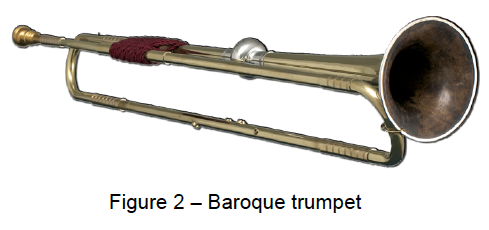Logan Anderson and David Brown, School of Music
The art of trumpet playing has existed for thousands of years, but today’s trumpet is a relatively new instrument. The addition of piston valves in the early 19th Century (see figure 1) allowed the trumpet to play in every key, while its predecessor (see figure 2) was limited to the harmonic series of only one key. The piston trumpet came about at the start of music’s Romantic period, but little Romantic music was written for the new instrument. As a result, there is a large gap in the trumpet repertoire. There are a number pieces for trumpet without valves from the Baroque and Classical eras, and there are many 20th century works for the modern trumpet. However, there is little to no solo repertoire for trumpet from the romantic era. The purpose of this project was to find great Romantic music that would lend itself well to the trumpet and transcribe those works for solo trumpet and piano.
Finding such works is not simple, as the stamina and air needed to play trumpet limits the lengths of phrases it can play. Moreover, the trumpet’s comfortable range is limited to two and one half octaves, making works from many instruments understandably more difficult to transcribe. In time, I chose to transcribe a selection of nocturnes by Polish composer Frederic Chopin. Chopin was a champion of the Romantic style and composed mainly for solo piano. The proposed nocturnes were from Chopin’s Opuses 9, 15, 27, and 32. Chopin’s nocturnes have a thin texture, using a single lined melody in the right hand while the left hand provides a simple accompaniment. The trumpet would would be able to play the melody found originally in the right hand, while the left hand could be played by a pianist for accompaniment.
To complete the project, I collaborated with my mentor David Brown, Associate Professor of Trumpet, whose extensive knowledge and experience of arranging and transcribing for trumpet was ideal for the task at hand. I also planned to study with renowned pianist Santiago Rodriguez, a former teacher of mine at the University of Miami. However, we could not coordinate our schedules.
As I studied the pieces for the transcription, I grew increasingly worried about thinning out the nocturnes’ already-sparse textures. I was also concerned with the pianist’s possible reaction to the removal of essentially half of the piece. It was possible he or she would grow bored of the part and find it musically unsatisfying. To my ears, the transcription sounded incomplete and unfulfilling, and I hit a creative block for some time. I didn’t want to add piano to the Chopin parts, but leaving them unchanged was also problematic.
Months later, I was speaking with a good friend who is a harpist. She was telling me about a performance she gave with another friend in which she played the role of a transcribed orchestra. Just then I recognized potential for trumpet and harp working together as a Chopin transcription. A harp playing the left hand piano part would not sound empty, as harps play arpeggios and accompaniment lines often. With her help I made a transcription of the left hands Nocturnes Nos. 1 and 2 from Opus 9. Harp transcription is similar to piano, but slightly trickier, as enharmonic notes and pedal switches must be accounted for.
We finished the transcriptions in time to perform them for my required junior recital in October of 2015. A recording of the performance is archived at the BYU School of Music. Transcribing six nocturnes in one year was, perhaps, too lofty a goal, and because of the delay in finding the correct instrumentation, only two nocturnes were completed and performed this year. Nevertheless, the project is ongoing, and plans are moving forward to include two more nocturnes in my required senior recital during the winter 2016 semester.
Upon completion of all the nocturnes, I will compile the transcriptions and submit them for publication. It has been a great joy to have even more music to play, and I firmly believe they will be a welcome addition to the trumpet’s repertoire upon publication.


